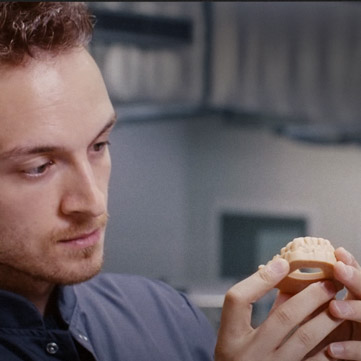
Additive manufacturing pushed the digitalization of the lab’s workflow much forward, improving efficiency and accuracy, and opening the road for new ground-breaking applications like Clear Aligners, something unfeasible with traditional manufacturing methods.
The 3D printers that you can find in dental labs are of three kinds: DLP®, SLA, and Material Jetting.
While each of these technologies can fit different specific needs, it is true that for precise, fast, and consistent results DLP® technology is clearly the winning one. Let’s see why, and how.
The advantages of DLP® vs SLA (and Material Jetting)
- Higher detail resolution: depending on the DLP® used, the minimum printable feature can be as small as 40µm, while with SLA the average is between 120µm and 180µm, a value linked to the laser beam spot size.
And even if theoretically it’s possible to reach smaller beam sizes, the drastic increase of the print time makes it not a viable option - Higher accuracy: It is good not to mix up the concepts of resolution and accuracy, even if they are somehow linked. Resolution is the smallest feature size that can be reached, while accuracy is how close measurement is to the true value.
As an example, you can have a printer with a very high resolution, but poor in accuracy. It means that your parts will be smooth and detailed, but totally off in terms of size, scale and shape compared to the original STL file.
Nevertheless, when it comes to printed parts tolerances, DLP® wins against SLA also in accuracy. - It’s a faster 3D printing techology, thanks to the high energy delivered to the resins (vs LCD) and no dependency from part geometry size (vs SLA).
For each layer, the UV DLP® projects high intensity images of the full slice of the object you are printing, while with SLA the laser has to «paint» the section of the object, literally the same you would do with a marker on a sheet of paper. So, bigger geometries require more time, while with DLP®s the size of the part does not affect the print speed. - Cheaper supports: Compared to material jetting technology, the quantity and costs of material needed for the support goes from zero to just a fraction.
- Reliability: DLP® are generically more reliable than laser+galvanometer solutions, they don’t suffer from print-heads clogging issues (print heads are used in jetting technology), and have no accuracy loss over time.
- Purchase price: Industrial DLP®s are usually less expensive than industrial SLAs